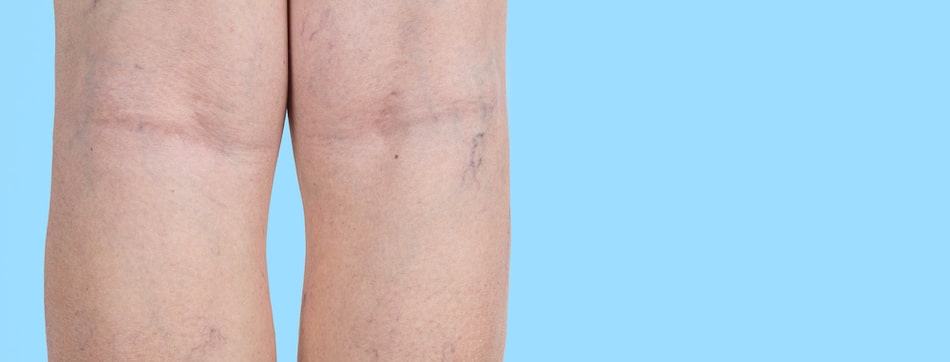
50% of adults suffer from having spider veins on the leg. If you are one of these adults, the statistic may give you some assurance that you aren’t alone. But when your legs are uncovered for all the world to see, it can feel like you’re the only person with this skin blemish. Luckily, there are non-invasive treatments for spider veins on the legs.
We share the two most popular treatments available to treat spider veins on the legs, what to expect from each procedure, and why you shouldn’t wait too long to address these skin imperfections. Each procedure has its own timeline for results, and we want to make sure your legs are summer-ready.
Spider veins (also called telangiectasias) are clusters of thin blood vessels or capillary veins visible through the skins’ surface. The web-like shape of spider veins is often dark red, blue, or purple. In most cases, the veins are benign and not a health concern but more of an annoyance of their presence. The dark color lines across the legs and the face aren’t the type of attention anyone would want.
There isn’t one clear or direct connection of how and why people get spider veins. Some experts point to genetic predisposition, but it’s more common for women to develop spider veins over men. Additional factors could be prolonged sitting or standing, aging, hormonal changes, pregnancy, and weight fluctuations.
There are two ways to treat spider veins for the legs. Both options are an outpatient procedure and are completely non-invasive. One option involves injections, and the other solution is laser treatment.
Sclerotherapy involves the injection of hypertonic saline (a very concentrated salt solution) into the spider veins. The irritation from the solution causes the spider veins to collapse and fade over time. Patients will notice smaller veins disappear immediately. However, the final results may take 3-6 weeks to appear, and it may take 2-3 procedures for all the veins to be treated. According to the American Academy of Dermatology (AAD), up to 90 percent of patients have seen a significant improvement after sclerotherapy.
Laser treatment is another option for spider vein removal. The laser is applied directly to the spider veins during the treatment and transmits photons into the blood cells absorbed by the veins. The light converts into heat energy, which effectively diminishes the appearance of the veins. The damaged vein shrinks and eventually dissolves over time. The main benefit of laser treatment is it can destroy spider veins without damaging your skin, and smaller veins are most likely to be eliminated instantly. The final results will appear about 4-6 weeks after the procedure but could take 2-3 sessions to address all the spider veins.
It is important to note that laser treatments work well on small and shallow veins. Any vein larger than a 30-gauge needle would have more effective results with a Sclerotherapy treatment with no size limit.
It is recommended to consult with a board-certified cosmetic surgeon or dermatologist where they can examine your legs for the most effective treatment option.
Treating spider veins with an injection treatment will require no anesthesia and is considered an outpatient doctor’s visit. The procedure could take 45-60 minutes to complete, depending on the number of veins to treat.
Laser treatment for spider veins can be done with a plastic surgeon or dermatologist in a medical office. The procedure could take 15-45 minutes, depending on the number of treated veins.
With these two treatment options, you will no longer have to cover up your legs from spider veins—what a relief, especially during the summer months. And even greater news is that each treatment is non-invasive and requires zero downtime. The most significant distinction between the two spider vein removal therapies is the size of the veins that are being treated.
Laser treatments for spider veins are most effective with small and shallow veins. However, laser therapy could be the only option for people with a phobia of needles.
Sclerotherapy doesn’t have restrictions on the size or shape of the veins but does require a series of injections to address spider veins and blood vessel clusters.
If your summer goal is to no longer worry or be embarrassed by the spider veins on your legs, we highly recommend finding a medically trained doctor who can help eliminate the skin blemishes on your legs.
Cosmetic Town is the premier online cosmetic news and information resource. We connect patients with the best doctors for cosmetic procedures. Get the answers to all of your questions and find a doctor near you.
- VM